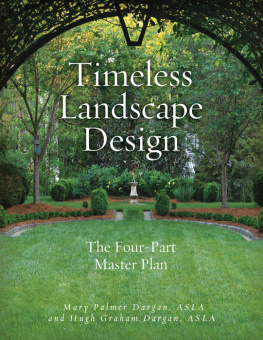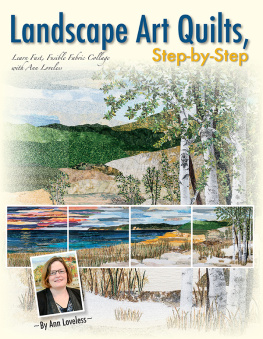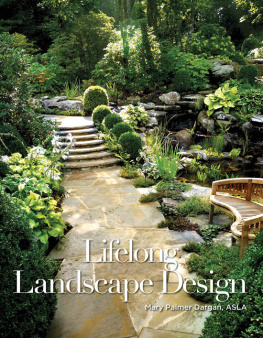Acknowledgments
Hugh and I currently enjoy careers that jointly span more than sixty-five years. So, it is with great appreciation that we thank our mentors in design education. Be they educators or orators, brick masons or carpenters, landscape contractors, horticulturalists or nurserymen, their gentle gifts of inspiration flowed from books and the classroom into the field where all great ideas are tested.
How did we become designers? Hugh thanks his grandmother, who helped him make a garden at the age of four. As an Eagle Scout in Darlington, South Carolina, he learned to honor the outdoors and to set goals for his life. His great-aunts shared their love of garden plants and propagation techniques of hostas, ligularias and camellias. We grew up in different parts of the South and each had large lawns used for birthday parties, weddings and competitions. In my great-grandmothers garden rooms in Nashvilles Belle Meade, pink-trumpet daffodils bloomed in the spring. Dykes Medal-winning bearded irises hybridized by Jesse Wills, a close neighbor, fugitive poet and dearly loved cousin, were wedding gifts to my mother.
Parents give in unexpected ways. Father, who loved to travel, fully experienced cultures. On our little Indian walks with the Girl Scouts, he would interconnect a bird call with an image in a great European painting or a sound in a musical piece. Mother, a retired businesswoman after three decades, loves historic house museums and works of art and excels in extending hospitality. They graciously allowed me to explore the world and to seek my purpose.
Our editor, Pete Wyrick, who helped us nurture this book for twenty years, believed it would finally happen. By sifting through the mass of information, he crystallized pearls of knowledge and helped bring atmospheric photographs into focus. He is a patient saint. Our publisher, Gibbs Smith, went out on a limb to support the authors quest to communicate design principles. We are most grateful for this rare opportunity.
Kate Bennett, our dear friend and early editor, took our lectures and made them into poetic paragraphs. We are endlessly thankful for her work in the early stages of this book.
No designer can create hundreds of built works without visionary clients. It is true that you are only as good as the commissions you receive. We thank them for their patience during construction and friendship at the garden christenings. Our devoted team of support staff, including interns from around the world, enabled us to produce works on paper that communicate the design intent and the implementation secrets that ultimately make us look good. We especially thank Eddie Browder, ASLA, who, during a decade, made the transition from Charleston to Atlanta with us and ultimately from the drafting table to the digital world.
My landscape architecture students at Clemson University and adult students in the Certificate of Landscape Design Course enthusiastically encouraged us to write this book in order to explain our residential design process to others. The teaching of this material continues to be a rich experience.
Many thanks go to the friendship of professional photographers, including Maia Highsmith of Special Gardens, Pauleetta Atwood, and particularly Alexander L. Wallace, who took the time to teach us the art of photography so we could capture these ephemeral gardens when opportunity knocked. Recently, making the film transition from 35mm and Hasselblad medium format to digital medium has been an image management experience for me that, in itself, is the best teacher. More than 7,000 images were sifted through to glean the final choices for this book. You have to stop somewhere. A designer is always in love with current projects, which need to mature further and are necessarily left for future books.
Landscape and architectural historic preservation groups, especially The National Trust in England and the Garden Conservancy in America, are to be thanked for perpetuating the visions of owners and designers. By introducing the public to experience exemplary built works of art, high standard of future designs are encouraged.
Botanical gardens such as Cheekwood in Nashville, Tennessee, and Brookgreen Gardens in South Carolina played a large role in our formative years of studying plants and their habitats. We heartily acknowledge environmentalists who recognize the genius loci, or spirit of a place, and work diligently to conserve its natural beauty.
We thank the English-Speaking Union of America, which provided the grant to study the evolution of Jan Kips eighteenth-century landscape drawings in Gloucestershire and to the Earl of Wemyss and his son, Lord Neidpath, who opened the doors of Stanway to our research. As a result, weve been canvassing England to uncover garden secrets ever since. The National Trust enabled our research at Newark Park, where we met the late Bob Parsons, who filled the sixteenth-century Tudor hunting box and landscape with life.
English garden writers, particularly those for Country Life, include Sir Roy Strong and the late Julia Trevethan Oman, the late Rosemary Verey, Penelope Hobhouse, Beth Chatto, Anita Periere, Mary Keen, and the late Sir Christopher Lloyd either befriended us, published our designs or accompanied us on visits to their gardens. Their written and built works provided inspiration to push the envelope of our designs with regard to plant material choices that consider each garden to be a nursery of delights. Gillian and Paul Sladen, our friends in Bath, hosted us with many an alfresco picnic under their catalpa tree vista and adventured with us to gardens in haute Normandy. We thank them for introducing us to Sir Harold Petos work at Iford and Buscot.
To all the British, American, French, Italian and Portuguese gardeners and garden historians who share the passion for garden design, we offer our endless thanks for your inspirations and ability to keep these treasures alive.
In the U.S., the Historic Charleston Foundation and the Preservation Society of Charleston keep the city treasures protected despite pressures of the times. To the families of the late Emily Whaley and Juliette Staats, we so appreciated your friendship and encouragement to the (then) young landscape architect couple who passionately wanted to understand Charlestons garden rooms, especially those designed by Loutrell Briggs. Dargan Landscape Architects works on paper are now housed in the archives of the South Carolina Historical Society in Charleston and the Cherokee Garden Library in Atlanta, and we are honored by their ongoing preservation.
The Garden Club of America is acknowledged for its work in archiving garden design, education in horticulture and conservation programs. The American Society of Landscape Architects and the Association of Professional Landscape Designers pre-sent awards for outstanding designs and publish residential works to encourage others to excel in this art form. We especially thank the ASLA for our national and state awards early in our careers, for these propelled our talents to larger audiences.









